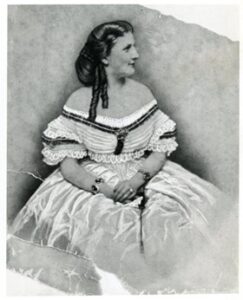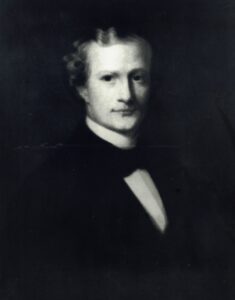Winter Wedding at Wheatland
A Marriage in High Life
While the month of January can be a quiet time at Wheatland today, it was not so quiet in 1866. In the chill of midwinter, Wheatland prepared for a wedding. Wedding guests filled the rooms, a chef prepared a special dinner, and family gathered together for the wedding of Harriet Lane and Henry Elliot Johnston.
Harriet’s wedding took place at Wheatland on 11 January 1866. The Luzerne Union Newspaper described the wedding as a “marriage in high life.” In today’s blog post, we’ll explore Harriet’s journey to her wedding day.
The Life of a Debutante

Harriet was an unconventional woman for her time in several ways, including her marriage later in life. She was 35 years old. Her husband was 34 years old. A later marriage was a result of the life she lived, which included education, travel, and public service as First Lady of the United States.
However, she did not shy away from the social life of a debutante. She seemed to charm everyone wherever she went. With such charms came potential suitors, like a certain Mr. Evans in 1852, whom Buchanan described as a “sour grape.”
There was also another suitor, Congressman Job Tyson, who proposed to Harriet when she was in London in the early 1850s. She, of course, declined his proposal.
In 1856, yet another suitor threw his hat into the ring. John Forney inquired about Harriet to one of her friends, Sophia Plitt. In a letter to Harriet, Sophia recounts the gossip:
“Poor Forney! He came twice to see me, Sunday tea, & stayed until 9 A.M….He made George believe he wanted to talk politics, wanted ‘all Nunc’s friends in Congress to vote for the expulsion of Brooks’ – & then enquired ‘in a voice so gentle’ if Miss Lane was engaged?” (Library of Congress, Series II, Harriet Lane Johnston Papers 1846-1887; Washington, DC, Sophia Plitt to Harriet Lane, 28 June 1856)
Her Own Deliberate Judgement
Throughout her life, Harriet maintained her own decision on love. In the case of Congressman Tyson’s proposal, Buchanan wrote to Harriet’s brother, Eskridge Lane:
“she shall decide” and “I know not what her determination will be.”
Indeed, James Buchanan appeared to let the decision rest with Harriet. Though he often would meddle with his own wishes for her life, Buchanan explained that she should maintain her own choice:
“It is my desire to see you happily married, because should I be called away your situation would not be agreeable. Still you would have plenty. Whilst these are my sentiments, however, I desire that you shall exercise your own deliberate judgment in the choice of a husband. View steadily all the consequences, ask the guidance of Heaven & make up your own mind; & I shall be satisfied.” (Moore, John B., “The Works of James Buchanan,” Vol. IX, 1853-1855, J.B. Lippincott Company, Philadelphia & London, 1909, p. 38).
Harriet’s Choice

In her own time, Harriet chose the man she would marry. On 22 August 1864, Harriet wrote a letter to her cousin, James Buchanan “Buck” Henry. In it, she mentions an interest in a gentleman:
“Henry Johnston was there & we renewed a great deal of our old acquaintance. On his part I think it was all renewed— what would you think if I did too?” (LancasterHistory Archives, MSS 95.694m, copied from original by F.A. Henry, Melbourne, 23 July 1937, Harriet Lane to J. Buchanan Henry, 22 August 1864).
Henry E. Johnston was a wealthy banker from Baltimore, Maryland. Their rekindled acquaintance soon blossomed into a marriage proposal.
The Wedding Day
And so, on 11 January 1866 at 1:00 PM, Harriet Lane married Henry E. Johnston at Wheatland. Harriet’s uncle Edward Buchanan (James Buchanan’s youngest sibling) officiated the ceremony.
According to the 12 January 1866 publication in the Intelligencer Journal of Lancaster, Pennsylvania, “the ceremony was quietly performed, in the presence of a few friends.”
The 31 January 1866 publication of the Luzerne Union of Wilkes-Barre, Pennsylvania lists 25 people in attendance, including Buck Henry, who first heard the news of the rekindled acquaintance between Harriet and Henry. James Buchanan was there, too, and the Luzerne Union describes the bittersweet moment for him:
“The ex-President was in fine health, and as happy as could be expected at a separation from a lady to whom he was so much attached, and whose refinement, accomplishments, and rare discrimination have been such invaluable agencies to him in his public, and especially in his Presidential career, and have been such faithful accompaniments of his declining years.”
After the ceremony, a cook named Augustin prepared a meal. Based on the number of guests and Buchanan’s practice of converting the parlor into a “Big Dining Room,” it is likely that the meal took place in the parlor.
From there, the couple would embark on 18 years of marriage before Henry E. Johnston’s death in 1884. But that story shall be for another day.
From History From The House